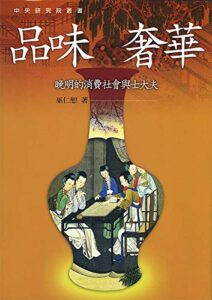
Wu Jen-shu 巫仁恕
Taipei: Academia Sinica 中央研究院, Lian jing chu ban shi ye you xian gong si 聯經出版事業有限公司, 2007
Reviewed by Sylvia Wun-sze Lee (Department of Fine Arts, The Chinese University of Hong Kong; HYI Visiting Fellow, 2009-2010).
To date, many studies about society in the late Ming dynasty have discussed the fact that consumer culture and a consumer market existed particularly in the urban centers of Jiangnan (江南). This book further elaborates this theme and investigates how the consumer culture and market influenced the scholar-literati circle by studying different social practices in everyday life.
The book consists of an introduction, six empirical chapters, and a conclusion. The first chapter gives the reader a brief overview of the development of consumer culture in the Ming dynasty. In chapters two through six, the author studies particular social practices to illustrate how the scholar-literati circle reacted to the changes in consumer culture and market in the late Ming dynasty. In chapter two, the author uses the example of the sedan-chair to illustrate how some consumption could be politicized, demonstrating the status and power of the consumer. In chapter three, the author uses clothing and accessories as an example to illustrate fashion trends in the consumer market of the late Ming, challenging the arguments of Fernand Braudel and S.A.M. Adshead in regard to the development of consumer culture in China. In chapters four and five, the author illustrates how the scholar-literati circle differentiated itself from the mass public with examples of travel and furniture. The idea of distinction of social status in the Ming was discussed by Criag Clunas in his book Superfluous Things. Here the author extends and expands Clunas’ discussion of art objects to everyday practices. Finally, the author suggests in chapter six that such consumer culture continued from the Ming to the Qing dynasty through the example of fine dining.
The author demonstrates his points with numerous textual and visual materials, providing a convincing picture of consumer culture in the late Ming dynasty with telling examples.
